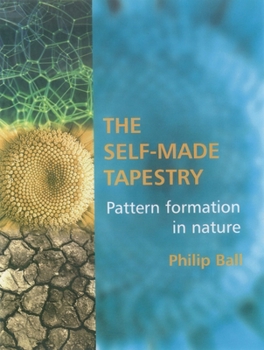The Self Made Tapestry: Pattern Formation in Nature
Select Format
Select Condition 
Book Overview
For centuries, scientists have struggled to understand the origins of the patterns and forms found in nature. Now, in this lucid and accessibly written book, Philip Ball applies state-of-the-art scientific understanding from the fields of biology, chemistry, geology, physics, and mathematics
to these ancient mysteries, revealing how nature's seemingly complex patterns originate in simple physical laws.
Tracing the history of scientific thought...
Format:Paperback
Language:English
ISBN:0198502435
ISBN13:9780198502432
Release Date:October 2001
Publisher:Oxford University Press, USA
Length:312 Pages
Weight:1.60 lbs.
Dimensions:0.7" x 7.4" x 9.7"
Customer Reviews
5 ratings
QUALITY BOOK
Published by Thriftbooks.com User , 15 years ago
GREAT OVERVIEW OF PATTERN FORMATION. FOR THE LAYMAN. LITTLE MATH. APPENDICES ARE NICE. PERHAPS MORE COULD HAVE BEEN SAID ABOUT SYMMETRY BREAKING. BUT, OVERALL, GREAT BOOK. VERY WELL WRITTEN AND ENGAGING.
Brilliant affirmation of Emanationism, of Phi and complexity-in-nature
Published by Thriftbooks.com User , 17 years ago
This is one of the finest affirmations of Emanationism of the Neoplatonists, i.e. that complexity in nature doesnt require Supernatural causes as exposited by Creationists. While this book does not deal with philosophical-religious principles, that its premise is the explaination for complexity in nature as merely Phi (golden section) ratios, it does provide the backbone for Emanationism, of the metaphore for the Cosmos in Platos Repuplic 509d-511 wherein Phi is given as the principle Logos (ratio/'tapestry') behind complexity in nature.
Masterful exploration of natural beauty
Published by Thriftbooks.com User , 18 years ago
This is a lyrical celebration of natural beauty and underlying complexity. Not only that, the book itself is beautifully typeset, composed and arranged. A real pleasure to read, aesthetically and intellectually. Sheer wonder.
Sad
Published by Thriftbooks.com User , 20 years ago
I hope some publisher will do the world a favor and keep this book in print. It's a classic that belongs on the shelf right next to D'Arcy Thompson's "On Growth and Form." This might seem strange for me to say, but if I were to design an educational curriculum for people learning my profession (oncology), this book would be mandatory. It is highly recommended for anyone interested in morphogenesis. If anyone knows where I can buy 10 or 20 unused copies, I'd appreciate hearing from you (wmshea@earthlink.net).
A brilliant overview of a complex sublect
Published by Thriftbooks.com User , 24 years ago
From the very begiing of rational inquiry, a small number of philosophers and scientific researchers in different fields have asked a rather large question: What are the characteristics of the physical world that drive the creation of complex structures? This is a question that goes beyond simply asking why shells spiral, or why snowflakes have symmetry; it asks instead why do tree branches, root systems and the dendritic structures of nerve cells all share a common structure? I've been curious about this question since my early grad school days, but for a long time the topic was thought at a minimum to be a rather eccentric one; many thought it simply unproductive, or even unscientific.But the last twenty years has seen an explosion in the areas of complexity, chaos and other studies that go to the heart of asking why the world is structured (on a macroscopic scale) the way it is, and why there are so many parallels of structure between seemingly unrelated entities.While there have been a great many books in recent years looking at that very question, "The Self-Made Tapestry" is this first really complete overview of the field and its history, and it's quite an accomplishment. Profusely illustrated, engagingly written, and marvelously clear, it's not only a wonderful reference book, it's marvelously entertaining to read as well.If you've found yourself in recent times pouring over Glieck's "Chaos", or perhaps Stuart Kauffman's books on self-organization, or Waldrop's "Complexity", you'll delight in this book. It's a good reference for the academic, a fine introduction for the interested layman, and a treat for every interested reader.





